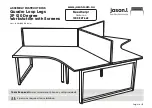
LCR7000 & RHEOSIGHTS P/N: 974194 |
Rev: A
|
ECO: 52468
www.dynisco.com
From lab to production,
providing a window into the process
-52-
One of the difficulties in acquiring accurate viscosity vs. rate data can arise from material
degradation during the test. ASTM D3835 states that when a material is unstable
(degrades >5% from the initial value) each shear rate must be run after a given residence
time in the barrel. That is, each rate requires a separate charge of the barrel, so that all
data are compared at the same residence time in the barrel. However, there are other
methods.
If only three or four unique rates are run during a test, some rates can be repeated at
various times. In this way an estimate of the degradation effects and shear rate effects can
be made at the same time. Indeed, interactions between rate and time can only be studied
this way. You may wish to review a paper given on this at a recent RETEC.
Constant shear rate vs. time runs may be collected at a number of different shear rates for
each charge of material then merged together. Data, taken from these graphs at constant
time, allow isochronal (constant time) curves of viscosity vs. shear rate to be obtained.
Extrapolation to viscosity vs. rate curves at zero time can also be accomplished with this
technique. How the viscosities vs. rate curves are affected by time at constant temperature
can then be evaluated.
In our in-house lab we have found a single rheometer day-to-day reproducibility of the
apparent shear viscosity in shear rate ranges of 10 to 1000 to be about 1.5 to 2.0% (1
standard deviation over the mean viscosity value, pooled estimate). The variation tends to
increase very quickly at lower rates. This variation value is in the same range as found by
17 labs participating in the D3835 round robin testing in 1991.1 This 2% value is used in
the reduced chi square estimate (RCS) shown with the fitted information in KARS. The RCS
tells how many standard deviations the fitted curve is away from the typical standard
deviation of a point.
Precision
The rheometer-to-rheometer reproducibility (for all capillary
rheometers in general, according to ASTM) is significantly higher than
that for a single instrument. The latest values are included in ASTM
D3835 precision and bias statement found at the end of the ASTM
document. The value is on the order of 8%. See ASTM method D3835
for a graphical display of round robin results.
7.
Combining Time and Rate Runs
8.
Accuracy and Reproducibility
















































